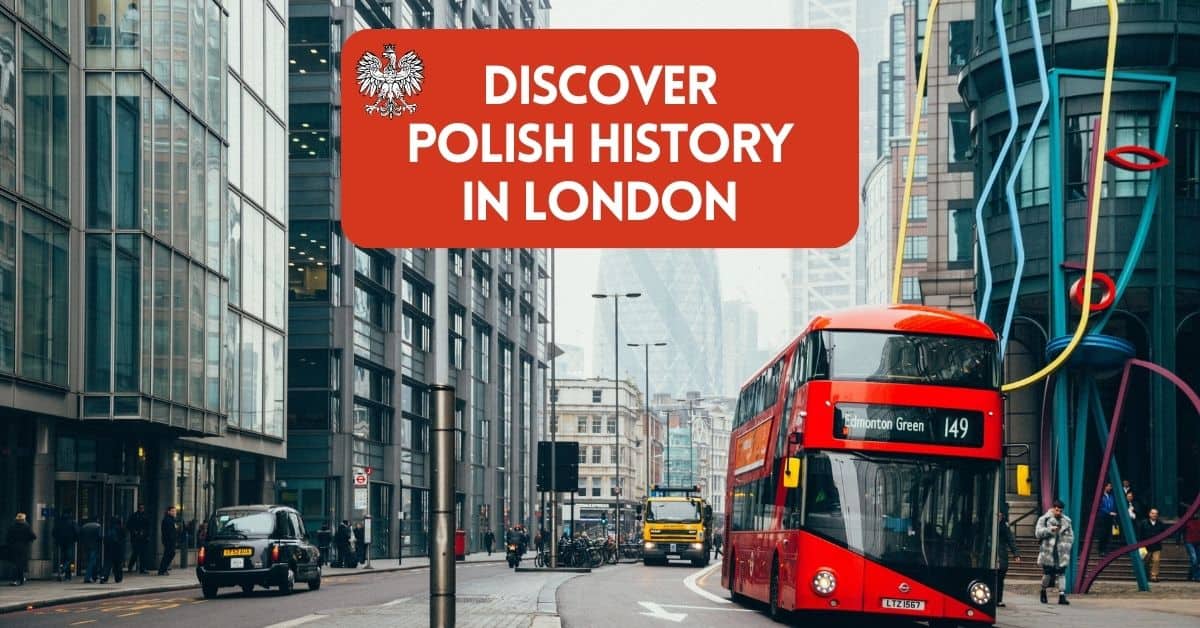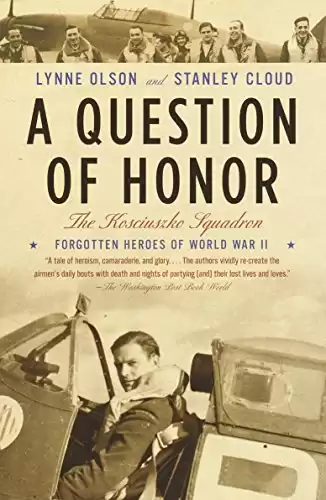Top 10 Polish History Sites to Explore in London
Polish heritage is deeply woven into the fabric of London’s history. From the contributions of Polish pilots during the Battle of Britain to the vibrant cultural exchanges that continue to this day, Polish history in London is both profound and inspiring. In this blog post, we’ll journey through the top Polish history sites in London, each offering a unique glimpse into the enduring legacy and contributions of the Polish community in the city.
The Places Where We Go contains affiliate links and is a member of the Amazon Services LLC Associates Program. As an Amazon Associate, we earn from qualifying purchases at no extra cost to you when you purchase using one of these Amazon links. Read our disclaimer and privacy policy for more information.
1. Polish Institute and Sikorski Museum
Nestled in the heart of South Kensington, the Polish Institute and Sikorski Museum is a treasure trove of artifacts, documents, and personal stories commemorating the Polish Armed Forces’ efforts during World War II and Poland’s broader history and cultural legacy. Established in 1945, it’s dedicated to preserving the memory and spirit of the Polish Armed Forces in the West—making it one of the most important institutions outside of Poland. The historic site is named after General Władysław Sikorski, the Prime Minister of Poland in exile and Commander-in-Chief of the Polish Armed Forces.
The collection includes items such as uniforms, weapons, artwork, photographs, and personal belongings of important figures in Polish history. The Sikorski Museum is a valuable resource for those interested in learning about Polish history, particularly during World War II. It also serves as a reminder of the contributions made by the Polish people to the Allied forces during the war. The museum hosts various events and exhibitions throughout the year, making it an engaging and informative visit.
You’ll find the Polish Institute and Sikorski Museum just south of Hyde Park at 20 Princes Gate in Kensington. The website says that appointments are not required, but they request advance notice if you plan to visit, as that helps them ensure guides are available.
We thoroughly enjoyed our visit and wished we had more time to view the artifacts. For anyone interested in Polish history, this is a must-stop in London.
TIP: Arrive early – viewing hours are limited. A late arrival will limit your ability to experience the museum’s collections.
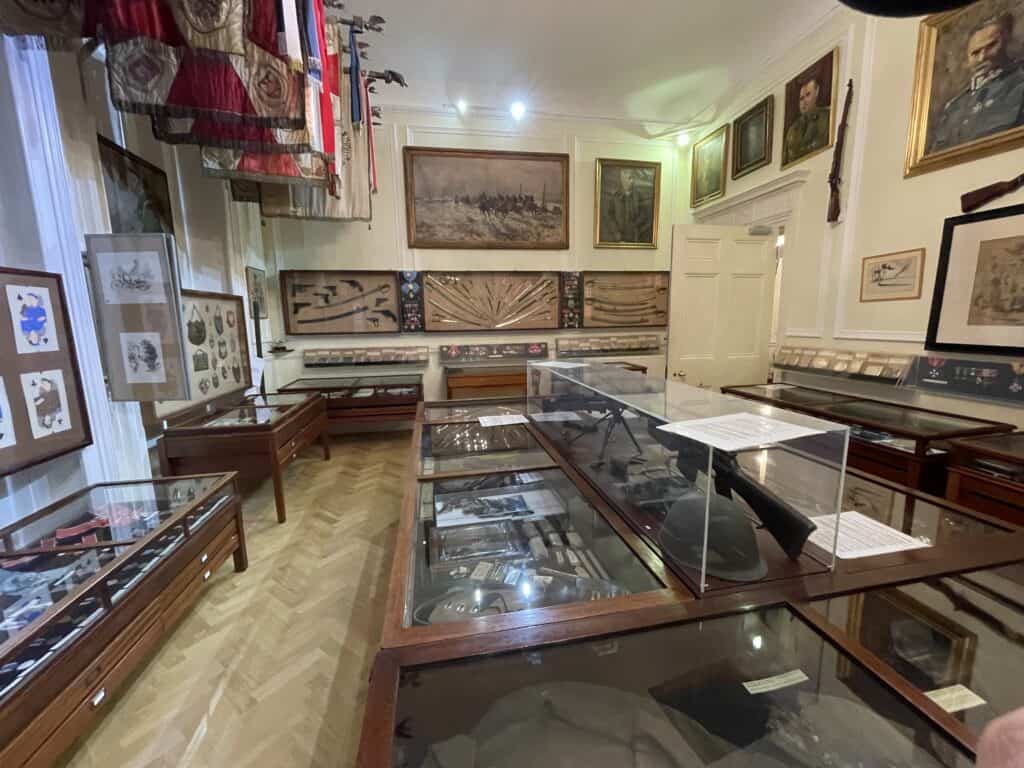
2. Katyn Memorial
A striking and somber landmark, the Katyn Memorial commemorates the massacre of over 20,000 Polish military officers and intelligentsia by the Soviet Union in 1940. The memorial, located in Gunnersbury Cemetery, is a powerful reminder of the tragic events in Katyn and throughout the larger Katyn Forest Massacre.
The Katyn Memorial was unveiled in 1976 and serves as a tribute to the thousands of Polish prisoners of war who were murdered by Soviet forces during World War II. It stands as a symbol of remembrance for those who lost their lives in the Katyn Massacre and serves as a reminder of the sacrifices made by the Polish people during this turbulent time in history.
The inscription on the monument reads, “In memory of 22,000 Poles murdered in Soviet Russia 1940.”
The centerpiece of the memorial is a large black obelisk structure. The inscription on the monument reads, “In remembrance of 14,500 Polish prisoners of war who disappeared in 1940 from camps at Kozielsk, Starobielsk, and Ostaskow, of whom 4,500 were later identified in a mass grave at Katyn near Smolensk.”
Below the obelisk, we read these words on a marker – “This casket contains soil from their graves murdered by the Soviet secret police on Stalin’s orders 1940. The soil hereunder came from their graveyard in 1990. As finally admitted in April 1990 by the U.S.S.R. after 50 years of shameful denial of the truth.”
During the Cold War, the Poles in the UK fought to erect this memorial and ultimately were granted permission to erect the monument in London.
Today, the Katyn Memorial is a place for mourning and remembrance and symbolizes hope and unity between the two nations. It is a significant part of Polish heritage in London and remains an important site for many Polish people living in England and visitors from all over the world.
And after visiting the memorial, we wandered around the cemetery. We took notice of the heavy Polish presence among the grave markers, including Jozep Hildebrandt – Colonel of the Polish Army, a grave to the 24th Polish Lancers, and so many others.
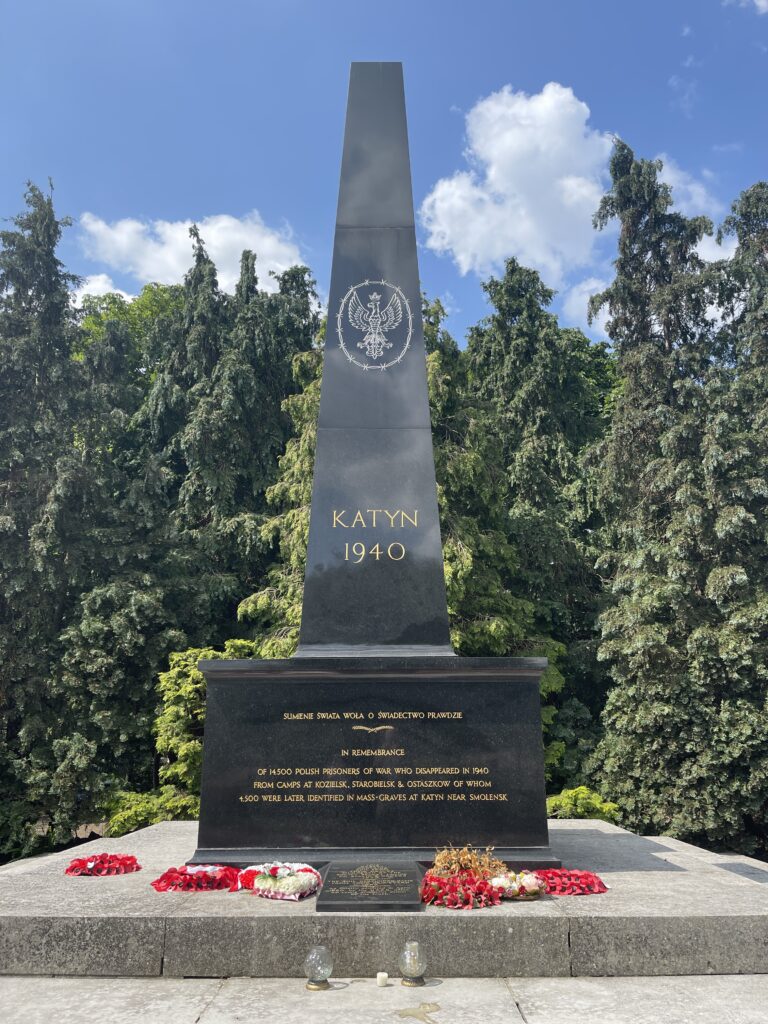
3. St. Andrew Bobola Church
This Catholic church in Shepherd’s Bush reflects the rich architectural style of late-19th-century Polish neoclassicism. It is a vibrant center for the local Polish community, serving as a place of worship and cultural engagement.
St. Andrew Bobola Church is a nod to the Jesuit who spread devotion to the Sacred Heart of Jesus in Poland during the 17th century and was canonized as a saint. The church’s intricate interior, with its ornate altars and historic paintings, presents a beautiful space that encapsulates Polish religious life and the community’s indelible mark on London.

Shepherd’s Bush: St. Andrew Bobola’s Polish R C Church by Dr Neil Clifton, CC BY-SA 2.0 https://creativecommons.org/licenses/by-sa/2.0, via Wikimedia Commons
4. Polish War Memorial at RAF Northolt
The Polish War Memorial at RAF Northolt is a significant tribute to the 2,000 Polish airmen who lost their lives during World War II while serving alongside the Royal Air Force. Unveiled in 1948, the memorial stands as a symbol of gratitude for the gallant efforts of the Polish Air Force, whose motto, “For your freedom and ours,” encapsulates their shared commitment to defeating tyranny. The site continues to be a place of annual commemoration and is particularly important during Polish Independence Day when dignitaries and veterans gather to pay their respects.

Nigel Cox / Northolt: Polish War Memorial (1)
5. Saint Clement Danes Church
The impressive St. Clement Danes Church, commonly known as the Central Church of the Royal Air Force, is an architectural feat in itself. This place of worship holds great significance for the Polish airmen and features several commemorative plaques honoring their service.
The church also houses the Polish Air Force Memorial, a striking black granite monument that is a centerpiece of the churchyard, paying homage to the brave Poles who made the ultimate sacrifice.
TIP: The Polish Air Force Memorial is easy to miss – at least, it took us a while to find it during our visit. You need to look down, as the marker is on the floor. You’ll find it on the left side of the church. It is one of the larger installations on the church floor and mentions various Polish Air Force contributors, including Squadron 303.
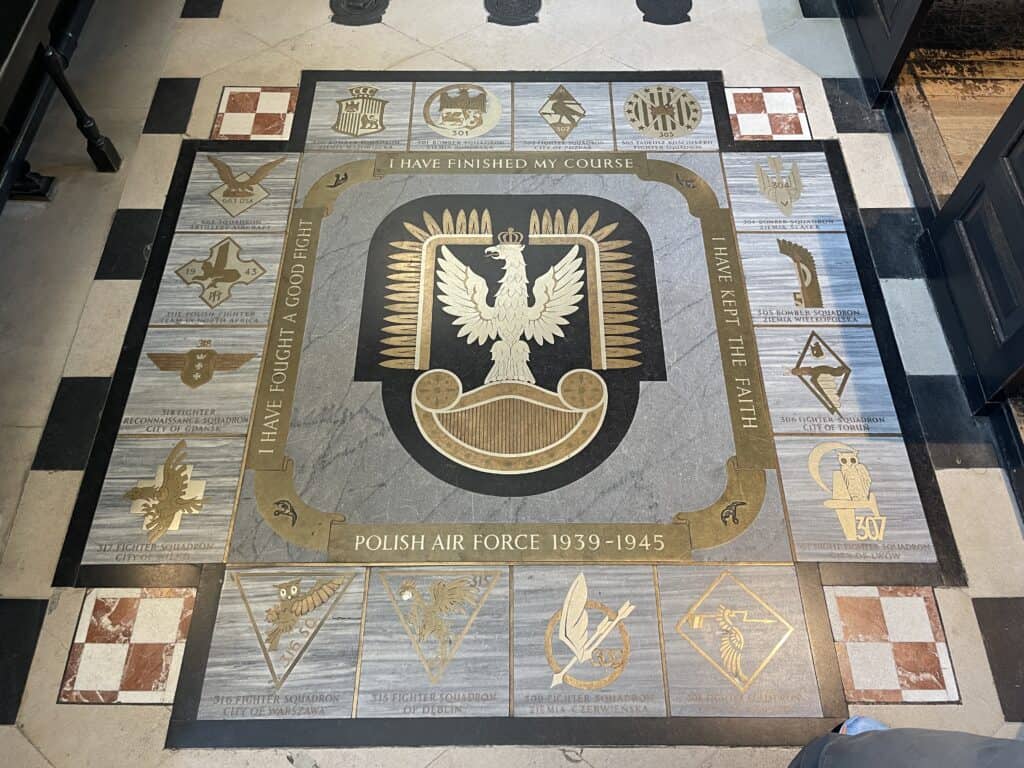
6. Rubens Hotel
The Rubens at the Palace Hotel is a luxury hotel in Victoria, central London. While it may seem like just another upscale accommodation option for visitors to London, the Rubens Hotel holds a special place in Polish history.
During World War II, the hotel was the headquarters for the Polish government-in-exile and was known as “The Polish Embassy in Exile.” Here, the government-in-exile, led by General Władysław Sikorski, worked to maintain and represent the interests of Poland while they were forced to operate from abroad. During this time, the hotel also served as a hub for important meetings and discussions between Polish officials and their allies.
A plaque outside the hotel reads: “General Sikorski – Prime Minister – Commander in Chief of the Polish Forces in the Second World War, had his headquarters in this building from 1940 until his tragic death at Gibraltar in 1943.”
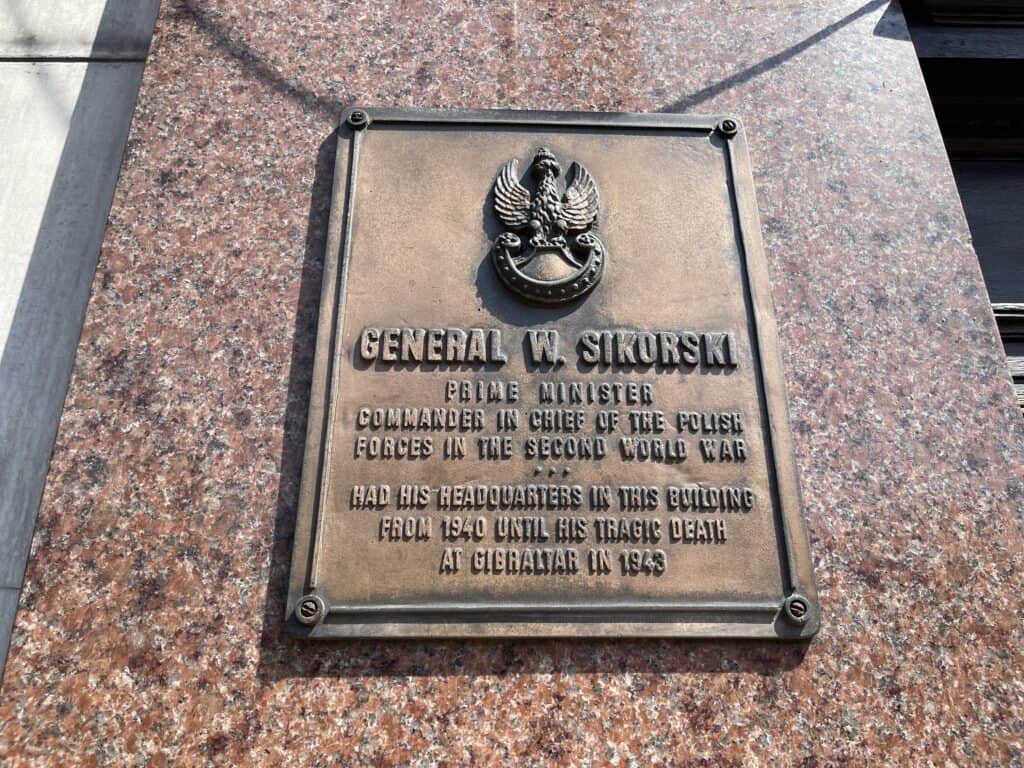
7. Battle of Britain Bunker
While not a Polish-specific site, the Battle of Britain Bunker in Uxbridge houses a permanent exhibit dedicated to the Polish airmen who served with the RAF. The bunker served as the operational nerve center for the RAF during the Battle of Britain, and its undercroft today is an immersive experience that transports visitors to the heart of the air campaign.
Inside, a new permanent exhibit was added to the museum’s collection to commemorate the 80th anniversary of the Battle of Britain. This display highlights the critical role of the Polish Air Force in concert with the RAF during the Second World War. The Polish Air Force exhibit at the Battle of Britain Bunker sheds light on the brave and challenging journeys that Polish Air Force personnel undertook during World War II.
The exhibit highlights pre-war Poland’s military preparations, the Polish Government’s organization in France and Britain, and the different roles within the Polish Air Force.
We viewed various objects, documents, and historical films that provided insights into combat missions and the stories of pilots, observers, ground crew, and the Polish Women’s Auxiliary Air Force.
Outside the bunker, you can walk the Polish Air Force Heritage Trail, which includes a tribute to Squadron 303.
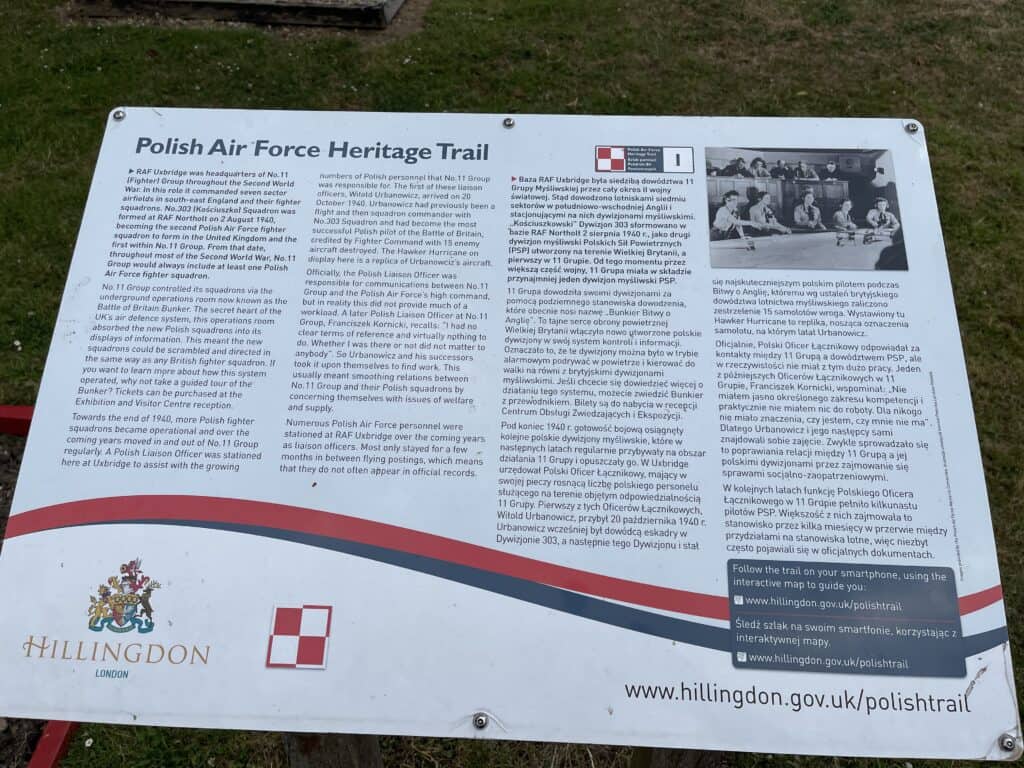
|
4.8
|
5.0
|
4.8
|
|
$26.00
|
$11.49
|
$15.21
|
8. POSK – The Polish Social and Cultural Association
Established in 1967 in Hammersmith, POSK promotes Polish culture, arts, and community in London. It is home to a library containing over 25,000 books in Polish, art galleries, a café, and a theater. Regular events, including concerts, exhibitions, and lectures, offer vibrant experiences of Polish culture. POSK stands as a testament to the dynamic and ongoing contributions of the Polish community to London’s cultural fabric.
KGGucwa, CC BY-SA 3.0 https://creativecommons.org/licenses/by-sa/3.0, via Wikimedia Commons
9. The Belvedere
Though not a site in the traditional sense, The Belvedere in Holland Park deserves mention for its historical connection to Poland. Once the residence of Prince and Princess Czartoryski in exile, it symbolizes the long-standing links between Polish nobility and the UK. Today, it’s a reminder of the shared history and enduring friendships that transcend borders and generations.
10. Trenchard Museum
While not in London, Polish history fans can consider taking a train to Wendover just north of London. In this picturesque town, the Trenchard Museum offers a fascinating glimpse into the Royal Air Force’s (RAF) history and its connection to Poland during World War II. The museum is named after Hugh Trenchard, considered the “Father of the RAF,” and houses exhibitions dedicated to young Polish members who served in the RAF during the war.
The museum’s exhibits showcase the critical role played by Polish pilots in the Battle of Britain and other significant air battles during World War II. It also highlights these brave individuals’ personal stories and experiences, including their training, daily life in the RAF, and contributions to Allied victory.
One of the most moving displays at the Trenchard Museum is the “Polish Area,” which honors the Polish airmen who lost their lives during the war. It features photos, artifacts, and personal items belonging to these fallen heroes, allowing visitors to pay their respects and remember their sacrifice.
The Trenchard Museum is an important place of remembrance for the Polish community in London and a reminder of the strong bond between Poland and the RAF during World War II. It is a must-visit for anyone interested in learning more about this important chapter in history.
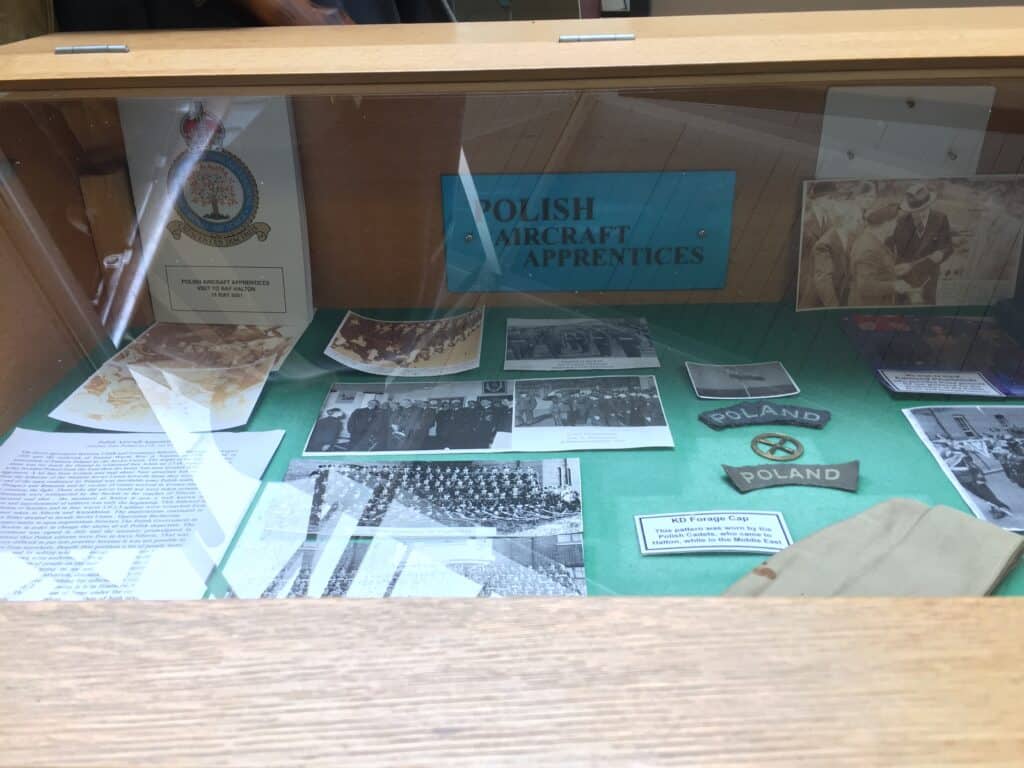
Enjoy Polish Food in London
If you’re looking to try traditional Polish cuisine in London, we recommend at least two Polish restaurants.
Ognisko Restaurant
Ognisko restaurant is the perfect place to go. Located in South Kensington, this elegant and upscale restaurant offers a menu of delicious and authentic Polish dishes.
From classic favorites like pierogi and bigos (hunter’s stew) to more modern takes on traditional dishes such as venison goulash or borscht with crispy duck, Ognisko has a wide-ranging menu. The restaurant also offers a variety of vegetarian and vegan options, making it accessible to all dietary preferences.
Initially founded in 1940 as a club for Polish officers during World War II, Ognisko has been a cultural hub for London’s Polish community for decades. The restaurant’s striking interior, with its high ceilings and ornate chandeliers, adds to its elegant and nostalgic atmosphere.
Located near the Polish Institute and Sikorski Museum, add this restaurant to your itinerary following a visit to this Polish museum. We recommend making reservations before your visit to Ognisko.
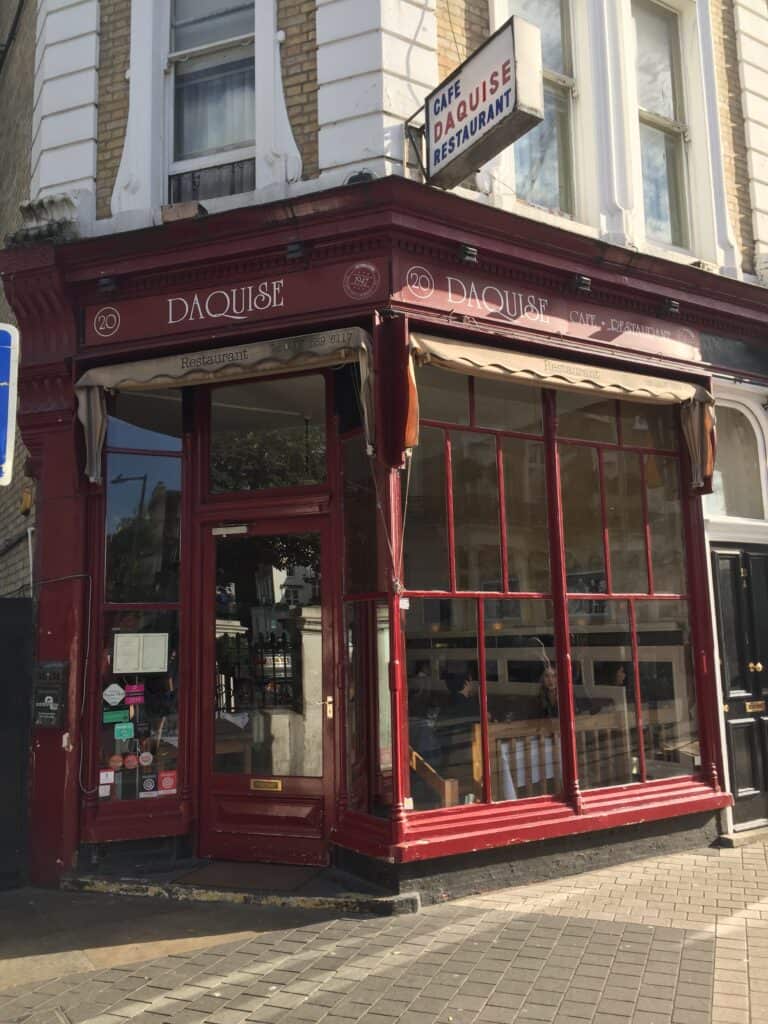
Daquise Restaurant
The first Polish restaurant we experienced in London was Daquise, and it holds a special place for us. Located in the trendy South Kensington area, this cozy and welcoming eatery has served traditional Polish dishes since 1947, earning a loyal following among locals and tourists alike.
Daquise’s menu features all the classic favorites, including pierogi, gołąbki (stuffed cabbage), and kielbasa (Polish sausage). They also offer a selection of hearty soups, such as żurek (sour rye soup) and barszcz czerwony (beetroot soup). For those with a sweet tooth, don’t miss out on their famous apple pie served with a dollop of whipped cream.
The atmosphere at Daquise is upscale and authentic, with traditional Polish decor and friendly staff. It’s the perfect spot to relax and enjoy a delicious meal after a day of exploring London.
In addition to their food, Daquise has an impressive selection of Polish beers and spirits, including Żubrówka (bison grass vodka) andWyborowa (Polish vodka).
Listen to our Polish Heritage Sites in London Podcast
Conclusion
London’s Polish history sites offer a fascinating journey through time, revealing stories of heroism, cultural exchange, and community spirit. These sites serve not only as memorials and cultural hubs but also as bridges connecting the past and present, inviting visitors to explore the rich contributions of the Polish community to London’s diverse tapestry.
Whether you’re a history enthusiast, a culture lover, or simply curious, these sites promise meaningful experiences that resonate with the stories of resilience, creativity, and friendship that define the Polish spirit in London.
More Things To Do in London
Discover London’s vibrant food scene
Fun things to do in London for couples

